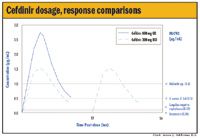- Case-Based Roundtable
- General Dermatology
- Eczema
- Chronic Hand Eczema
- Alopecia
- Aesthetics
- Vitiligo
- COVID-19
- Actinic Keratosis
- Precision Medicine and Biologics
- Rare Disease
- Wound Care
- Rosacea
- Psoriasis
- Psoriatic Arthritis
- Atopic Dermatitis
- Melasma
- NP and PA
- Skin Cancer
- Hidradenitis Suppurativa
- Drug Watch
- Pigmentary Disorders
- Acne
- Pediatric Dermatology
- Practice Management
- Prurigo Nodularis
- Buy-and-Bill
Article
Cephalosporins for perioperative prophylaxis
National report - Cephalexin (Keflex, Dista and generics) and cefdinir (Omnicef) are both well-tolerated when administered orally for infection prophylaxis in patients undergoing in-office cutaneous surgical procedures.

However, relative differences between those agents with respect to pharmacokinetics and antimicrobial activity may make cefdinir a preferred choice, particularly in cases where a prolonged operative time is anticipated, according to James Q. Del Rosso, D.O., clinical associate professor of dermatology, University of Nevada School of Medicine, Las Vegas.
Dr. Del Rosso discusses the findings from a prospective, placebo-controlled, investigator-blinded study in which he compared the two cephalosporin antibiotics in patients who were either undergoing excisional surgery for a cutaneous tumor on the trunk or extremities (n = 200) or Mohs micrographic surgery for a skin cancer on the head, neck or upper extremities (n = 100). Within each surgical subgroup, patients were randomized 2:2:1 to receive a single dose of cephalexin 2 gm, cefdinir 600 mg or placebo - four capsules administered two hours prior to the procedure. However, patients who would be considered to have a greater need for antibiotic prophylaxis, such as those with an artificial cardiac valve, valvular heart disease or recent joint prosthesis, were randomized only to an active treatment.
Postoperative wound care was standardized and excluded use of a topical antibiotic.

"In considering the implications of this study, it is important to note that the indications for antibiotic prophylaxis in dermatologic surgery are not well-defined. The risk of a serious postsurgical infection is low, especially in the setting of simple procedures involving skin that is not contaminated or infected. However, as dermatologists weigh the potential morbidity and mortality associated with that outcome against the overall safety and negligible cost of the prophylactic treatment, perioperative antibiotic use is common, and particularly when performing surgery in patients at risk for endocarditis or prosthetic infections," Dr. Del Rosso notes.
"The results of this relatively small, office-based study do not provide conclusive evidence regarding the role of antibiotic prophylaxis or whether cephalexin or cefdinir might be a better choice because any trial designed to address those issues would require a much larger study population. However, cefdinir provides more potent activity than cephalexin against a number of important skin pathogens, such as staphylococci and streptococci, as well as a longer serum half-life, and those features suggest it may be more optimal."
Argument for cephalosporins
He explains that cephalosporins are a rational choice for antibiotic prophylaxis in cutaneous surgery patients because they offer good activity against the gram-positive organisms that are the most common pathogens in postoperative infections and are extremely well-tolerated, even when administered in the higher doses that would be used for surgical prophylaxis.
"After the tetracyclines, which are used predominantly in dermatology for patients with acne and rosacea, the cephalosporins are the next most common class of antibiotics prescribed by dermatologists. Widespread experience over approximately three decades supports their overall excellent safety and rare association with any significant side effects, especially with use of the oral agents," Dr. Del Rosso says.
However, cefdinir may also be distinguished from cephalexin from a safety perspective in terms of risk of hypersensitivity reactions.
"There is a chance for cephalexin to cross-react with some penicillins, and so cefdinir has been reported to be a safer choice in patients with a history of penicillin allergy. This is based on a recent thorough evaluation of penicillin-cephalosporin cross-allergenicity," he explains.
Disclosure: Dr. Del Rosso is a consultant and speaker for Medicis.





